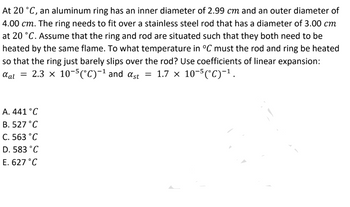Question

Transcribed Image Text:At 20 °C, an aluminum ring has an inner diameter of 2.99 cm and an outer diameter of
4.00 cm. The ring needs to fit over a stainless steel rod that has a diameter of 3.00 cm
at 20 °C. Assume that the ring and rod are situated such that they both need to be
heated by the same flame. To what temperature in °C must the rod and ring be heated
so that the ring just barely slips over the rod? Use coefficients of linear expansion:
αal = 2.3 × 10-5(°C)-¹ and αst = 1.7 × 10-5(°C)−¹.
A. 441 °C
B. 527 °C
C. 563 °C
D. 583 °C
E. 627 °C
Expert Solution
This question has been solved!
Explore an expertly crafted, step-by-step solution for a thorough understanding of key concepts.
This is a popular solution
Trending nowThis is a popular solution!
Step by stepSolved in 3 steps with 2 images

Knowledge Booster
Similar questions
- A copper rod and an aluminum rod of equal diameter are joined end to end in good thermal contact. The temperature of the free end of the copper rod is held constant at 100°C, and that of the far end of the aluminum rod is held at 0°C. If the copper rod is 0.32 m long, what must be the length of the aluminum rod so that the temperature at the junction is 50°C? marrow_forwardA copper rod and an aluminum rod of equal diameter are joined end to end in good thermal contact. The temperature of the free end of the copper rod is held constant at 100°C, and that of the far end of the aluminum rod is held at 0°C. If the copper rod is 0.50 m long, what must be the length of the aluminum rod so that the temperature at the junction is 50°C?arrow_forwardA copper rod and an aluminum rod of equal diameter are joined end to end in good thermal contact. The temperature of the free end of the copper rod is held constant at 100°C, and that of the far end of the aluminum rod is held at 0°C. If the copper rod is 0.42 m long, what must be the length of the aluminum rod so that the temperature at the junction is 50°C?arrow_forward
- A pair of eyeglass frames are made of an epoxy plastic (coefficient of linear expansion = 1.30 10-4°C-1). At room temperature (20.0°C), the frames have circular lens holes 2.40 cm in radius. To what temperature must the frames be heated if lenses 2.41 cm in radius are to be inserted into them?arrow_forwardAn aluminum ring has an inner radius of 4.9973 cm at room temperature (20 °C). A copper ball has a radius of 5.0035 cm at the same temperature. To what final temperature (in °C) must you heat the ring for the ball (starting from room temperature) to be able to pass through it? (The linear thermal expansion coefficient for aluminum is 2.34 * 10-5 °C-1 and for copper is 1.76 * 10-5 °C-1.)arrow_forwardA metal rod has a starting length of 240 cm. When the temperature changes from 25 °C to 110 °C, the length of the rod changes 0.115 cm. What is the linear expansion coefficient of the rod?arrow_forward
arrow_back_ios
arrow_forward_ios